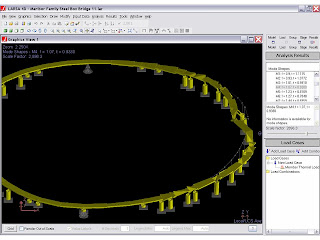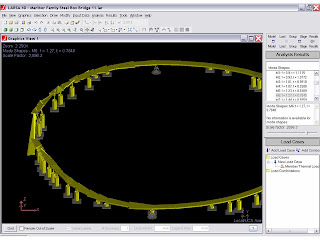The structure used for the analysis is as follows.
- The box girder is: 3.2m wide, 0.5m deep, 15mm thick top and bottom flanges, 10mm thick side webs
- The columns are all 250 mm solid steel. The column quantity is 38 total (20 on the long side, 18 on the short side)
- The piles are hollow steel 1mm in diameter with a thickness of 50mm
1) Lateral Vibration - Natural Frequency is 1.1 Hz

2) Vertical Vibration - Natural Frequency is 1.3 Hz

3) Torsional Vibration - Natural Frequency is 1.5 Hz

4) I was not able to find any deflection criteria for vibration. There are deflection criteria for (static) vertical loads, but these shouldn't be an issue for us, since we intend to use fairly standard box girder sizing and span lengths. Based on the research on the Millenium Bridge in London, the minimum allowable lateral natural frequency is ~1.3 Hz. The American AASHTO standard says that pedestrian bridges with natural frequencies less than 3 Hz require additional analysis to determine if they are acceptable. (My to do list: I will look up the static deflection criteria and let you know. This is separate from any vibration issues)
5) The pedestrian Live Load on the bridge is 85 pounds per square foot, per American (AASHTO) design standards. This works out to 12 Kilonewtons per meter of bridge length. The Dead Load (self-weight) of the box girder is 8 Kilonewtons per meter of bridge length. (My to do list: Make a sketch showing the dead load, live load, and approximate column loads. Determine the wind loads and any other relevant loads.
1 comment:
Rad thanks Scott. Not too bad with the frequency. If only it were the structure we're showing in the plans. Haha. No worries, we'll figure that all out after we win.
Post a Comment
Note: Only a member of this blog may post a comment.